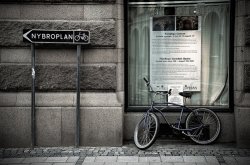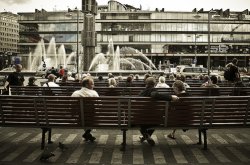For the OP....
As you move from point and shoot to making photographs - both in terms of equipment and how you approach the craft - you will face three different inter-twined learning curves:
1) Thinking photographically: Simply put a camera records a scene differently than how our brains process what our eyes see. In real life our eyes have a wide, nearly 180 degree field of vision and are constantly darting about really only focusing on whatever has captured our attention at the moment.
Our eyes are attracted by contrast and we get "tunnel" vision because our brains tune out what isn't in the center of the field of vision where all the color receptors are located on the retina of the eye. Ironically, the thing which a still photo can't capture - movement - is the type of contrast which attracts the eye the most. It is an ingrained survival trait. In simpler times detecting a slight movement in an otherwise still field of grass could mean the difference between finding dinner or becoming dinner to a hungry Lion.
When shooting the camera will record distractions in the background our brains will tune out unless we train it to look for them. When compositing a photo we need to keep in mind the natural tendencies of the eye and brain to dart about constantly, being attracted by contrast, and tuning out the less important parts of the scene. A thoughtfully composed photo will lead the eye of the viewer along an interesting path to the most important part of it where the message of the photo is. That is done with a combination of where the center of interest is positioned in the frame to create balancing negative space for the eye path and how strongly it contrasts with overall tone and distracting clutter of the background.
Before shooting a photo I ask myself these questions: 1) What is the message I want to convey to the viewer? 2) What strategies will create the desired emotional reaction when they see it? 3) What in the scene will distract from delivering the message and how can it be minimized or elminated? Defining a goal for the photo and thinking in terms of the emotional message various strategies would evoke helps to quickly narrow down which techniques would be most effective.
For example if making a portrait outdoors the goal would be to draw the viewer into the eyes of the subject to make strong eye contact because eye contract is a key factor in reacting emotionally to faces we see. The best strategy for drawing the viewer to the face is to make to contrast the most with everything else. How best to contrast it will vary depending on the clothing and background. Ideally the clothing and background should blend together and contrast with the face so if the subject is wearing a dark shirt I'd look for a dark background but if wearing white I'd look for a light one. When selecting the background I'd try to find a non-distracting one or employ techniques such as narrow DOF to blur a distracting one; which will signal the brain of the viewer that it is less important than the sharply focused face. With experience that whole process becomes instinctive and instantaneous.
The difference between a "snap shot" and making a photographic statement is being aware of the factors which will affect the perception of the image and identifying and manipulating those which can be controlled when capturing the image.
2) Understanding the technical limitations of the capture process: You are not going to capture images like those you posted out of the camera. In fact you may initially be disappointed in the image quality of photos coming out of your first DSLR at its default settings because as a general rule the more sophisticated the camera is the less the images tend to be manipulated in the camera because the manufacturers assume the photographer will want to do most of the manipulation in editing on a more powerful computer. That's the idea behind RAW format.
The biggest limitation of the camera is that it really only sees in three colors - red, green and blue - over a limited brightness range. You will need to learn how to use the tools on the camera such as the histogram and overexposure warning to get the highlights exposed correctly. Getting the highlights correct - as judged by the brightest detail - is actually quite easy if you use a white textured reference object. I carry a white terry washcloth in my bag. I have the subject hold it, then adjust exposure until its brightest parts start to black out in the overexposure warning (OEW). Testing has shown me when than happens the exposure is perfect. For other subjects where I can use the towel the OEW on the brightest areas in the scene become my gauge. Get the highlights exposed correctly and the maximum range of the sensor will be used. Beyond that, there's not much more which can be done with a single exposure in the camera when shooting RAW.
Experience is the only way to learn the limitations of your equipment and how it records a scene. The first thing I do when I get a new camera is put it in its default "dumb" auto mode and go around and shoot stuff with and without flash. That allows me to understand what its autofocusing and metering baselines are and how it handles difficult situations such as backlight, and how it differs from cameras I used previously. When I switched from film to digital and from P&S digital to DSLR I had to change my shooting techniques to get the best results with the new equipment. That type of "baseline" testing helped me quickly identify what I needed to re-learn. Your camera will not adapt to your old habits so you need to adapt your habits to how it does things best.
3) Post Processing: If shooting RAW every image captured in the camera needs post processing. Even if shooting JPG and the WB and everything else is ideal the image will still need to be sharpened to compensate for the mosaic pattern of the sensor. In most instances the overall contrast the camera sensor captures will not match the contrast the eye saw in person and it also doesn't not respond to differences in tone as the eye does naturally. So just to get a "normal" rendition of a scene requires manipulation of the image contrast and color saturation. In Photoshop there are literally a dozen different methods to do that, which in part is why the editing process is so confusing to neophytes. Ask for advice on post processing and you will get a dozen different suggestions for the "best" method.
I've used Photoshop since the first version in the early 1990s when there were not as many manipulation options. Levels is the first and remains the simplest way to adjust contrast. If you have a white object in your photograph simply running "AutoColor" will usually do a pretty good job of correcting it.
The two best tools you can use for controlling digital are a gray card and the white towel. The white towel will help get the exposure perfect. The gray card, photographed in a test shot, will help get the color balance perfect. A shot of the card can be used to set custom WB in the camera and then in Photoshop it will allow the use of another powerful tool, the "snap to neutral" eyedropper. Clicking on the image of the card in a photo will correct both the color balance and exposure in a way similar to AutoColor. The main difference is that the changes are based on the known neutral value of the card. That correction can then be saved and applied to all the other photos taken under the same lighting.
There are various paths you can take to get from where you are now to making photos like those you posted. The quickest path is to simply buy a plug-in. The longer but better path in the long run its to understand and overcome the technical limitations of the medium by first learning to match what your eye sees as closely as possible before attempting to alter reality creatively. Both approaches are equally valid but the latter will teach you more than the former. I've got about 40 tutorials which you may find helpful if you decide to take the longer road:
http://super.nova.org/DPR/
Chuck Gardner



